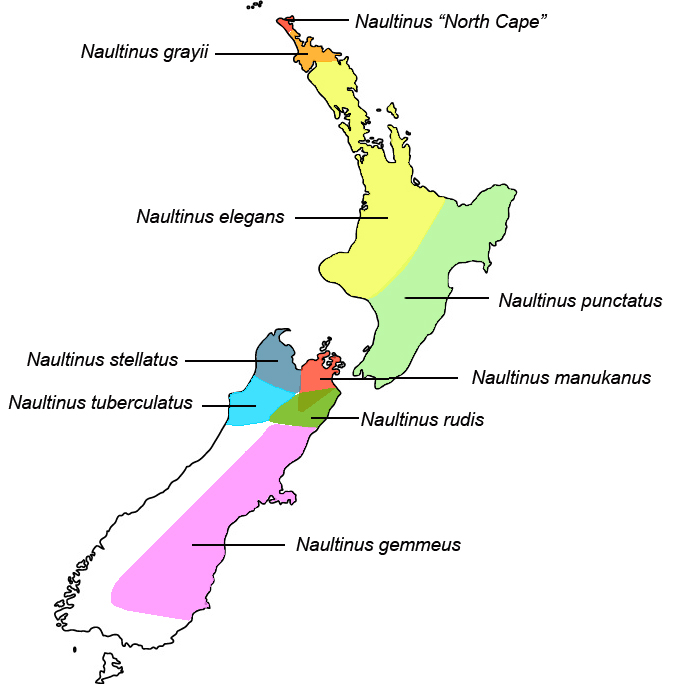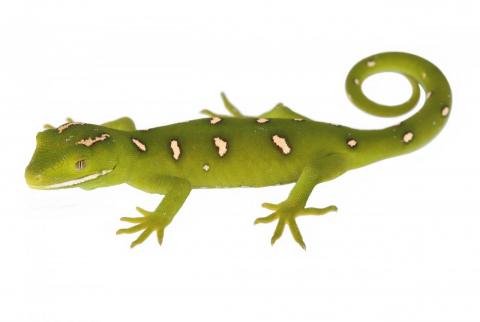Image attribution: elegant gecko (Naultinus elegans). © Nick Harker

Below is a table compiled in order to more easily compare and contrast features of the various Naultinus species.
Species
Colouration
Distribution
Mouth
Eyes
Feet
Size
Aupouri green gecko - N. ‘North Cape’ (also. North Cape green gecko / yellow-lipped gecko)
Bright green, often uniform or marked by 2 rows of white or yellow blotches or stripes (often finely edged with black) down each side of body. Patterns may be edged with black o a darker shade of green.
Aupouri Peninsula, northern North Island
Lining of mouth pink to lilac. Edge of gums yellow to orange- this featue visible when mouth closed.
Tongue red/orange.
Light orange/brown
Soles are light grey green.
66–82mm SVL.
Northland green gecko - N. grayii (also. Gray's gecko)
Dorsal surface green, often with grey or gold markings along dorsal edges. Males may have faint pale blue flanks. Ventral surface bright pale green, sometimes with yellow tinge.
Upper Northland, Bay of Islands to Houhora Harbour area.
Deep blue lining of mouth with bright red tongue. Lower lip white.
Light orange/brown.
Soles are light grey green.
80-100mm SVL.
Elegant gecko - N. elegans (also. Auckland green gecko)
Bright green to dark green often marked by 2 rows of pink, yellow, or cream to white blotches/stripes (often finely edged with black) down each side of body. Some individuals have only one or two spots near the tail rather than a full set of spots on either side of the body, while others are only partially striped. Juveniles are pale green with the dorsal surfaces being darker; darker dorsal colour is lost between the first and second moult. Bright canary yellow form may have recessive gene that exhibits lack of pigment in chromophores.
North of Taranaki in North Island. There are currently four island populations: Limestone Island, Great Barrier Island, Little Barrier Island, Waiheke Island.
Lining of the mouth rich blue with a black to bluish/black tongue.
Light orange/brown.
Soles are light grey green.
55-75 mm SVL
Barking gecko - N. punctatus (also. Wellington green gecko)
Bright pale to bluish green dorsal surfaces, sometimes flecked with fine black marks and rows of pale green, yellow or white patches (usually not outlined as with other species). Males may have bluish flanks. Ventral surface a pale green.
Lower North Island:
including Mana and Kapiti Islands.
Lining deep blue with black or bluish back tongue.
Light orange/brown
Soles are yellow.
75–95mm SVL.
Marlborough green gecko - N. manukanus (also. Manuka gecko)
Soft richly textured plain green, sometimes displaying faint golden star like markings on dorsal surface. Males have a pale bluish underbelly while females have a pale yellow/green underbelly.
Northern South Island: Marlborough area as well as on some of the Cook Strait and Marlborough Sounds Islands.
Pink lining with orange/red tongue.
Light to dark olive brown, pupils sometimes have pale border.
Toes are slender with expanded pads.
60–81 mm SVL.
Starred gecko - N.stellatus (also. Nelson green gecko)*
Highly variable in pattern and colour. Dorsal surfaces are bright to dark olive green with rows of large transverse splotches which are white, light green or grey brown and sometimes outlined with fine black lines. Ventral surfaces light grey or brown with pale streaks or stripes. Males often sport grey or chocolate brown ‘background’ colours with green markings. Young are born dark green with white markings, but change to their adult colouration at 18 months to two years of age.
Northwest South Island: Nelson province from Bryant Range to the western coast.
lilac mouth lining. Tongue pink/red.
Orange/brown or light to dark olive. Pupils sometimes have pale border.
60–81mm SVL.
Rough gecko (N. rudis)
Dorsal surface is light grey to pale brown (some males have a dark chocolate brown) with rows of transverse white/pale green/grey brown patches (sometimes edged finely with black lines). Ventral surface pale grey or brown with longitudinal stripes.
Northeast South Island: inland Marlborough and northern Canterbury.
Lining of the mouth dark blue/grey; tongue dark grey/blue, can transition to pink at the tip.
Dark green eyes with pupils often highlighted with pale border.
< 77mm SVL, overall lengths of up to 175mm.
West Coast green gecko -N. tuberculatus (also. Mossy gecko)
Mossy appearance, due to complex patterns of white and yellow shades against green colouration of body. Ventral surfaces paler than dorsal.
West Coast, South Island
Lining of mouth blue; tongue dark blue/black.
Dark olive, pupils often have pale border.
Toes narrow and tapering, soles of feet and toes yellow or yellowish green in colour.
77-85mm SVL.
Jewelled gecko (N. gemmeus) Canterbury form
Dorsal (upper) surface is typically a bright green or olive, while the ventral (lower) surface being pale grey to green/yellow, usually with longitudinal streaks/stripes. Most males are grey/brown all over with females being patterned (though this is not a definitive indicator of sex). Diamond shaped patches or continuous stripes cover the back and tail, this ‘jewelled’ pattern can be: white, yellow, green, grey or pinkish in colour.
Canterbury region
Lining of mouth is pink or mauve. Tongue pink/orange with some individuals having a dark grey base to the tongue.
Olive green to brown, pupils often highlighted with a pale border.
70-90mm SVL (with tail longer than SVL).
Jewelled gecko (N. gemmeus) Otago form
Dorsal surfaces a bright green with rows of diamond shaped patches or narrow stripes along the length of the body. Stripes may be pale green or white/yellow. Males more commonly have thin stripes while females are more likely to have diamonds, however, this is not a definitive indication of sex.
Otago region
Lining of mouth mauve to deep blue with a blackish tongue.
Olive or brown.
70-90mm SVL (with tail longer than SVL).
Note: dorsal = upper surface; ventral = lower surface; SVL = snout to vent length.
* Most amateur herpetologists separate Nelson green gecko into three varieties according to their local population area. Hence we have Maitai Valley, Nelson Lakes, and Sandy Bay N. stellatus. These varieties should be kept in separate enclosures in a captive situation.
A note on hybridisation: it is important that different species of green gecko are not housed together in captivity as they may breed and produce hybridised offspring. HYBRIDS ARE NOT NECESSARILY STERILE. Although hybrids have been produced in the past due to a lack of understanding, genetic studies have shown that there are six distinct species of green gecko which should not intentionally be interbred in captivity.
References
- Fischer, S.M. (2013). Conservation biology and wildlife management in New Zealand: endemic reptile species, urban avifauna, and wetland ecology (unpublished BSc honours dissertation). Massey University: Auckland, New Zealand.
- Gill, B.J., & Whitaker, A.H. (1996). New Zealand frogs and reptiles. Auckland: David Bateman Limited.
- Hitchmouth, R.A. (1979). The ecology and behaviour of two green gecko (Naultinus) species (Unpublished master’s dissertation). University of Auckland, Auckland, New Zealand.
- Jewell, T. (2011). A photographic guide to reptiles and amphibians of New Zealand. Auckland: New Holland Publishers Ltd.
- Nielson , S.V., Bauer, A.M., Jackman, T.R., Hitchmough, R.A., & Daugherty, C.H. (2011). New Zealand geckos (Diplodactylae): Cryptic diversity in a post-Gondwanan lineage with trans-Tasman affinities. Molecular Phylogenetics and Evolution, 59, 1, 1-22.
- Robb, J. (1980). New Zealand amphibians and reptiles in colour. Auckland, New Zealand: Collins.
- Robb, J., & Hitchmough, R.A. (1980). Review of the genus Naultinus grey (Reptilia: Gekknonidae). Records of the Auckland Institute and Museum, 16, 189-200.
- Soderstrom, P. (1977). Observations and questions. Moko, October/November 1977: 6.


